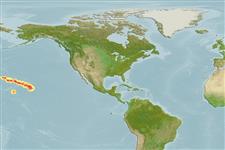Monachus schauinslandi Matschie, 1905
Hawaiian monk seal| Native range | All suitable habitat | Point map | Year 2050 |

|
| This map was computer-generated and has not yet been reviewed. |
| Monachus schauinslandi AquaMaps Data sources: GBIF OBIS |
Классификация / Names народные названия | синонимы | CoL | ITIS | WoRMS
Mammalia | Carnivora | Phocidae
Environment: milieu / climate zone / пределы глубины / distribution range экология
батидемерсальный; пределы глубины ? - 305 m (ссылка 122680). Tropical; 90°N - 12°N, 175°E - 147°W
Distribution страны | регионы FAO | Ecosystems | места находок | интродукции
Pacific Ocean.
Length at first maturity / Size / Weight / Возраст
половая зрелость: Lm ? range ? - ? cm Max length : 240 cm TL самец/пол неопределен; (ссылка 1394); 210 cm TL (female); наибольший вес (опубликованные данные): 200.0 kg (ссылка 1394); наибольший вес (опубликованные данные): 200.0 kg
Life cycle and mating behavior половая зрелость | размножение | нерест | Eggs | Fecundity | Larvae
Основная ссылка
ссылки | координатор | соавторы
Jefferson, T.A., S. Leatherwood and M.A. Webber 1993 FAO species Identification Guide: Marine Mammals of the World. Rome, FAO. 320 p. + 587 figures. (ссылка 1394)
Статус Красного Списка МСОП
(ссылка 130435: Version 2025-1)
Статус СИТЕС (ссылка 108899)
CMS (ссылка 116361)
Угроза для людей
Использование человеком
рыболовство: коммерческий
FAO - рыболовство: Видовой профиль | FishSource | Sea Around Us
инструменты
дополнительная информация
половая зрелость
Fecundity
нерест
Eggs
Развитие икры
Larvae
ресурсы в Интернет
BHL | BOLD Systems | CISTI | DiscoverLife | FAO(рыболовство: Видовой профиль; publication : search) | Fishipedia | GenBank (Геном, Нуклеотид) | GloBI | Gomexsi | Google Books | Google Scholar | Google | PubMed | Tree of Life | Wikipedia (Вперёд, поиск) | Zoological Record



